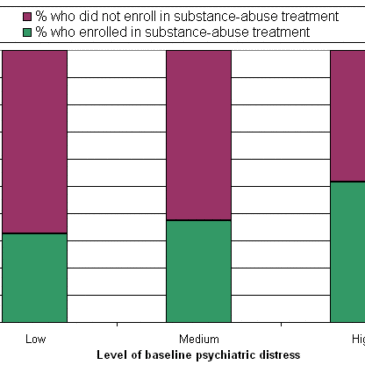Needle-exchange programs (NEPs) hold the potential to reduce drug-related harms by promoting safer drug-injection practices and by serving as a bridge to treatment for substance abuse. Yet, few NEP participants (5-11%) take advantage of available treatment referral services (Kidorf et al., 2005; Riley et al., 2002). This week’s STASH reviews a recent study that investigated a potential moderator of substance abuse treatment enrollment among NEP participants (Kidorf et al., 2010). Based on data from national epidemiological studies (e.g., Cohen, Feinn, Arias, & Kranzler, 2007), Kidorf and colleagues (2010) hypothesized that NEP participants who have concurrent psychiatric distress are more likely to enroll in treatment for substance abuse than their counterparts who have relatively little concurrent psychiatric distress.
Methods
- This study was conducted in collaboration with the Baltimore Needle Exchange Program.
- Data for this study came from a larger randomized evaluation of strategies designed to promote substance abuse treatment enrollment (Kidorf et al., 2009). The evaluation study compared the effectiveness of two experimental conditions against standard enrollment practices (i.e. treatment as usual).
- Study participants were 281 opioid-dependent individuals with an average age of 41 years. The study population was largely male (71.2%), unmarried (89.7%), and African-American (72%).
- Researchers used the Symptom Checklist 90-Revised to generate a measure of participants’ overall psychiatric distress. On this scale participants indicate the extent to which they feel a variety of forms of distress (e.g., depression, anxiety, hostility).
- The central outcome was whether participants enrolled in substance abuse treatment (inpatient or outpatient) during the 4-month study period.
- The authors used a frequency distribution to classify participants into three groups of roughly the same size (i.e. low, medium, or high baseline psychiatric distress). Then, they used logistic regression to evaluate the relationship between baseline psychiatric distress and substance abuse treatment enrollment (with the low baseline psychiatric distress group serving as the reference group), after controlling for demographic variables, randomized treatment enrollment condition, baseline drug use severity, and syringe exchange sites.
Results
- Overall, 40% of participants enrolled in substance abuse treatment during the course of the study.
- As Figure 1 shows, participants with high baseline psychiatric distress were more likely to enroll in substance abuse treatment (M = 52% enrollment) than participants with low levels of baseline psychiatric distress (M = 33% enrollment) (adjusted OR = 2.15, CI = 1.10-4.23, p < .05). Participants with low levels of baseline psychiatric distress did not differ from participants with medium levels of baseline psychiatric distress (M = 36% enrollment).

Figure. Proportion of participants who did and did not enroll in substance abuse treatment as a function of baseline psychiatric distress. Based on data reported in Kidorf et al. (2010). Click image to enlarge.
Limitations
- The levels of substance abuse treatment enrollment were higher than what typically is reported (Kidorf et al., 2005; Riley et al., 2002). This was likely the result of at least two aspects of the study. First, only participants who were not already receiving substance abuse treatment at baseline were included in the study. Second, about two-thirds of participants were exposed to an intervention designed to promote treatment enrollment. These aspects of the study might limit the generalizability of the study’s findings.
- Different forms of concurrent psychiatric illness might differentially be related to the decision to seek treatment for substance abuse. However, the authors did not explore this possibility.
- It appears the authors did not also measure enrollment in psychiatric services.
Discussion
People who use needle-exchange programs are more likely than the general population to suffer from psychiatric disorders in addition to their substance abuse. Most commonly, these disorders include major depression, post-traumatic stress disorder, and antisocial personality disorder (Kidorf et al., 2004). These disorders create distress, impair functioning, and exacerbate substance abuse problems. However, the current study suggests that higher levels of psychiatric distress might be beneficial to the extent that they motivate people to seek treatment for substance abuse. The authors speculate that psychiatric distress might motivate treatment-seeking because it increases self-perceived functional impairment, reduces the reinforcement value of substance use, or reflects a combination of these processes. Knowledge about this potential moderator of treatment seeking might be used to better match NEP participants to appropriate referral services.
–Heather Gray
What do you think? Please use the comment link below to provide feedback on this article.
References
Cohen, E., Feinn, R., Arias, A., & Kranzler, H. R. (2007). Alcohol treatment utilization: Findings from the National Epidemiologic Survey on Alcohol and Related Conditions. Drug and Alcohol Dependence, 86, 214-221.
Kidorf, M., Disney, E., King, V., Kolodner, K., Beilenson, P., & Brooner, R. K. (2005). Challenges in motivating treatment enrollment in community syringe exchange participants. Journal of Urban Health, 82, 456-467.
Kidorf, M., Disney, E. R., King, V. L., Neufeld, K., Beilenson, P. L., & Brooner, R. K. (2004). Prevalence of psychiatric and substance use disorders in opioid abusers in a community syringe exchange program. Drug and Alcohol Dependence, 74, 115-122.
Kidorf, M., King, V. L., Neufeld, K., Peirce, J., Kolodner, K., & Brooner, R. K. (2009). Improving substance abuse treatment enrollment in community syringe exchangers. Addiction, 104, 786-795.
Kidorf, M., King, V. L., Peirce, J., Burke, C., Kolodner, K., & Brooner, R. K. (2010). Psychiatric distress, risk behavior, and treatment enrollment among syringe exchange participants. Addictive Behaviors, 35, 499-503.
Riley, E. D., Safaeian, M., Strathdee, S. A., Brooner, R. K., Beilenson, P., & Vlahov, D. (2002). Drug user treatment referrals and entry among participants of a needle exchange program. Substance Use & Misuse, 37, 1869-1884.




